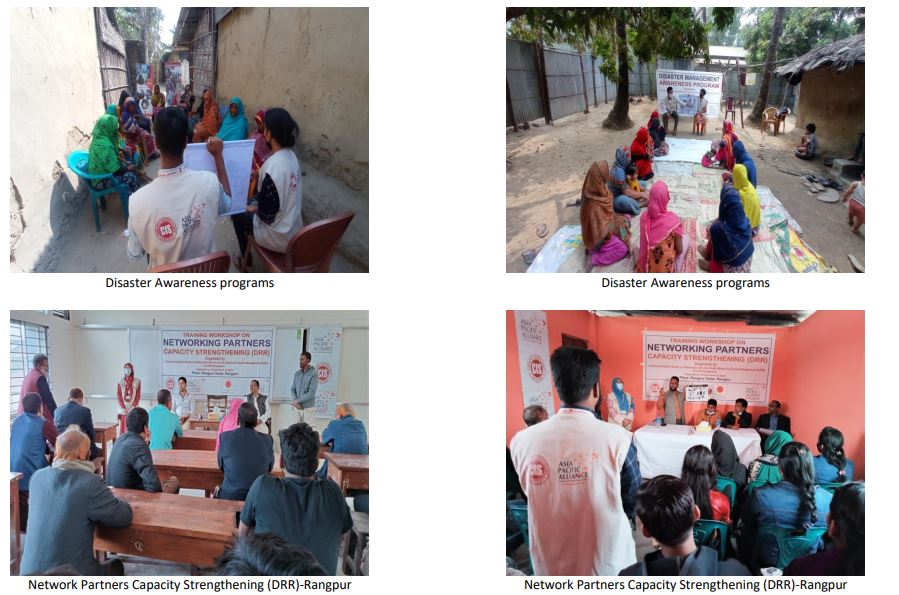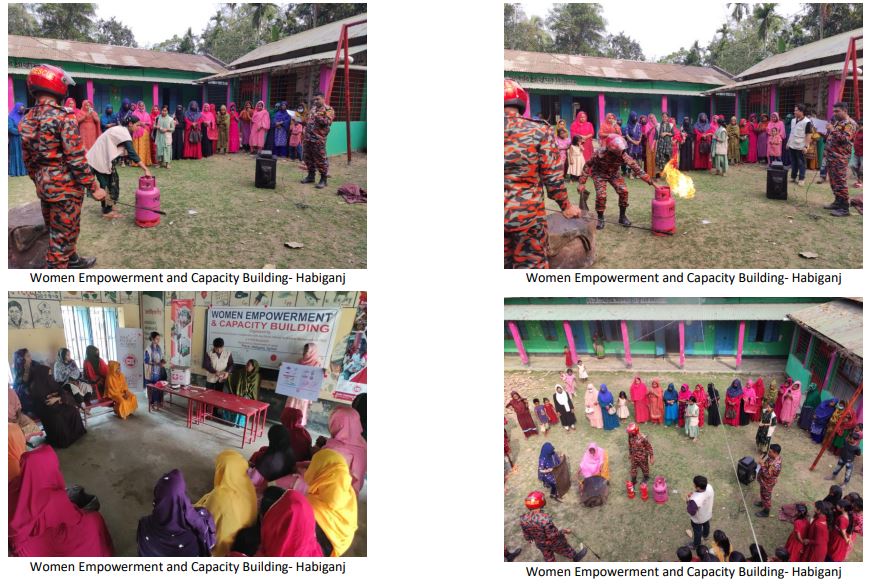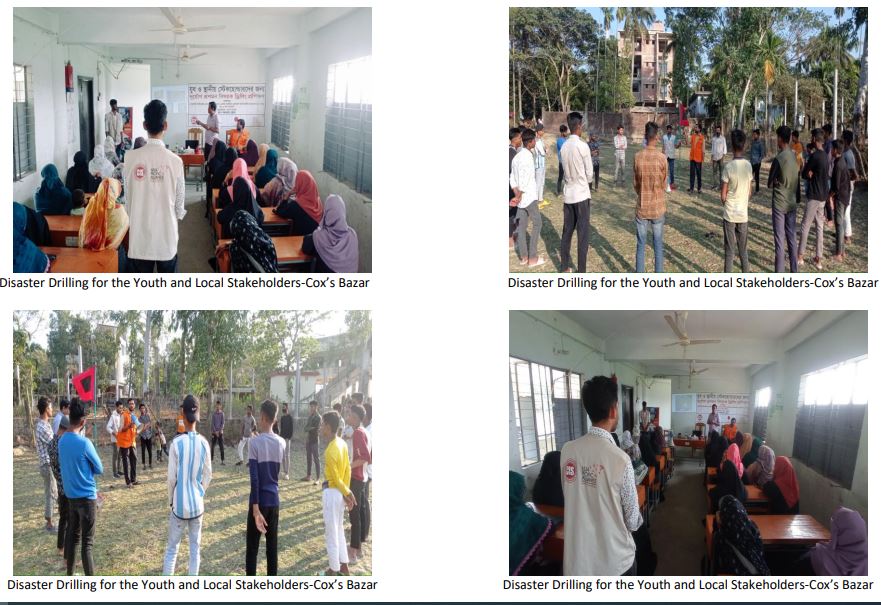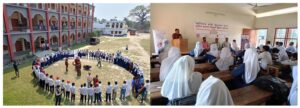Project Title: Strengthening Capacity for Sustainable Disaster Management Network by involving multi-sectoral platform Project Period: 17 January, 2023 – 16 January, 2024 (12 month)
- Project Activities and Accomplishments
Bangladesh is one of the most vulnerable countries to natural disasters and, due to climate change; we are facing natural disasters almost every year. Combined with the country’s geographical location, topography, and dense population, disaster events often result in high loss of life and economic loss, though Bangladesh has been successfully reducing the loss of human lives over the years. The frequency and intensity of natural disasters have been increased in recent years due t o climate change. The climatic events have serious consequences on broad agricultural sectors, food security, water, health and sanitation and leave serious impacts on life and livelihood of the communities. But so far we have limited disaster risk related data to understand the depth of household and population characteristics and loss sustained by the community at the household levels.
A-PAD Bangladesh started project from January 2023 and presently continue it 17 January 2023 to build up capacity on disaster management. It communicates with the different sectors like local community, community leaders, stakeholders, GOVT. officials continuing training on disaster management. To hold training program A-PAD Bangladesh staff organized small community meeting to sharing ideas on disaster and introduced them about A-PAD Bangladesh activity. A-PAD Bangladesh working 8 divisional areas.
There are 1 health workers in each divisions whose are doing home visit and aware the local community about basic disaster awareness. The health workers gave basic ideas about disaster management. A-PAD Bangladesh working at the rural areas. If there would be any directions or announcement from GOVT. or any disaster related news has been published the health workers delivered the message to the local community. Total 3,845 persons were benefited from A-PAD Bangladesh on February 2023.
A-PAD Bangladesh attended coordination meeting at the 8 divisions in Office of Deputy Commissioner. At that meeting different NGOs had joined and explained their activities. Besides this what will be the next activities of the GOVT. and NGOs were discussed at that meeting.
1. To manage the emergency disaster management coordination centers in disaster-prone areas (Outcome 1) The disaster management coordination center in disaster vulnerable areas established in this project (3 year project) functions as a disaster response base in each region, and contributes for preventing the spread of health damage to local residents and community-led disaster risk reduction measures. | ||
Activities | Outcome Indicators to Measure Results: | Project Status: Achievements vs Outcome: If the activity is behind the schedule, please write the reason. |
1-1 Operation of Emergency Disaster Management Coordination Centers Beneficiaries: 10 people x 25 days x 8 divisions x 12 months = 24,000 people 50 people x 8 campaign x 12 months = 4,800 people | 【Indicators of Outcome】 1-1: The disaster response management centers in 8 places (Dhaka, Chattagram, Rajshahi, Khulna, Barisal, Sylhet, Rangpur and Mymensingh division) will be utilized and the necessary equipment for emergency health care will be prepared. We will establish a new emergency disaster management coordination center in Mymensingh division. The center will function as a resource center for sharing information on disasters and will be used as a venue for strategic planning meetings, training and workshops. The staff members including doctors and nurses visit the villages and carry out awareness activities related to emergency health measures, public health and disaster prevention for local residents, and ensure that each local resident takes appropriate preventive measures. | Total 2,759 people visited to the Disaster Management Coordination Center to discuss about disaster preparedness and health related issues. Dhaka: 368 Persons Cox’s Bazar: 385 Persons Pabna: 350 Persons Bagerhat: 342 Persons Patuakhali: 376 Persons Habiganj: 388 Persons Rangpur: 350 Persons Netrokona: 200 Persons Total = 2,759 Persons |
1-2 Disaster Management Awareness program Beneficiaries:15 participants x 3 sessions x 8 divisions x 12 months = 4,320 people | A-PAD Bangladesh conducted Disaster Management Awareness programs at the 8 divisional areas where 389 persons have participated. Total 3 times training organized at each divisional areas. Dhaka:15 Participantsx 3 Sessons= 45+5=50 Participants | |
2-2 Disaster Preparedness Campaigns
Participants:100 people x 2 times x 8 divisions = 1,600 people | cooperation framework.
2-2 For the aim of awareness and increase the knowledge on disaster preparedness and management among the local community, we will organize different rally and meeting on the disaster preparedness and SDGs related |
|
2.3 Network Partners | national/international days like 05 November World | A-PAD Bangladesh conducted 2 days training program |
Capacity Strengthening | Tsunami Awareness Day, 13 October Disaster Risk | Rangpur where total 60 participants has joined the |
(DRR) | Reduction Day, 22 April Earth Day and 16 December | training programs. |
Participants:30 people x 2 | Victory Day (National). | 11-12 February 2023, Rangpur, Total Participants 60 |
org x 8 divisions x 2 times |
| A-PAD Bangladesh conducted a Training workshop on |
=960 people | 2-3 For the aim of strengthening of partner | Networking Partners’ Capacity Strengthening (DRR) to |
| organizations, disaster risk reduction (DRR) training | improve Disaster Risk Reduction and build up capacity in |
| will be held. | an emergency. A total of 60 participants from Local |
| The training contents includes community-based disaster | organizations and the Local community joined that |
| risk management, planning DRR strategies, and risk | training workshop. Specifically, There were present Two |
| analysis that effectively identifies hazards, capacities and | NGOs 1. The Hunger Project Bangladesh and 2.Setu Rural |
| vulnerabilities. | Development Society (SRDS). In that training workshop, |
| (Indicator: Partner organizations) | CIS introduced its goal, mission, vision and activity. On the |
|
| 1st Day SRDS joined in the workshop and Md. Motabber |
| 2-4 In this seminar, participants from various fields | Hossen shared that In Rangpur we should work on |
| will be invited to exchange opinions and discuss ways | Earthquake and fore Disaster Response as Earthquake and |
| to discover innovations related to DRR proposed by | fire is a sudden accident, which turns a calm environment |
| community residents and local companies and realize | suddenly into chaos. We can form a Disaster Management |
| ideas and inventions. | Committee and at a time train them for skill development |
| (Indicator: To create innovative solutions, we aim to | Therefore, everyone from personnel to family needs to |
| create a successful model for disaster response by combining technology and knowledge that transcends fields and innovating)
2-5 The international symposium will be held in Dhaka to widely share the cooperation between multi-actors at the central and regional levels in Bangladesh and the progress of the emergency health response system among participants who are involved in disaster response from inside and outside Bangladesh. International experts will be dispatched from A-PAD member countries to introduce advanced cases of NPF in each country. (Indicator: The international symposium will be held for a total of three days, one day for field trips (field visits), one day for pre-meetings, and one day for international symposiums.) | know about the final steps to deal with natural disasters and take steps. Strengthen monitoring and early warning systems: Early warning systems can provide crucial information about impending disasters, giving people and communities time to prepare and take action. Build community resilience: Strong communities are better able to withstand the impact of disasters. This can be achieved by promoting social cohesion, strengthening local institutions, and empowering communities to take an active role in disaster risk reduction efforts. Overall, strengthening disaster risk reduction requires a multi-faceted approach that involves all levels of society, from individuals and communities to national and international organizations. By working together, we can reduce the impact of disasters and build more resilient communities. |
2-4 Seminar for Developing New Disaster Prevention Solutions Participants:40persons x 8 divisions x 2times =640 participants |
| |
2-5 International Symposium on DRR |
|
|
Participants:200 persons |
|
3. Strengthening disaster resilience of local communities
(Outcome 3) 3-1 Disaster response capacity building of local community level in Health and hygiene field | ||
3-1 a) ) Workshop on Disaster Management and Emergency Health Response
Participants:40 persons x 8 divisions x 2 times = 640 persons | 【Indicator of Outcome】 3-1 a) Workshops will be held to understand emergency disaster preparedness, health response and hygiene needs in communities, schools and homes and to learn how to respond during emergencies. Networks of stakeholders will be built through the workshop.
(Indicator: Local citizens, Community leaders, Local NGO, Private sector workers)
b) Workshop for healthworkersfrom local organizationswillbeheld to understand emergency health and hygieneneeds and learn how to respond to emergencies. The healthworkerswhofinishedthis trainings are supposed to becomemember of disastervolunteerrescue team in the activity. | A-PAD Bangladesh conducted workshop at 2 divisional areas Pabna and Patuakhali where total 87 participants had joined the workshop. 15-16 February 2023, Patuakhali, Total 40+5 participants 22-23 February 2023, pabna, Total 40+2 participants
The immediate priority after a natural disaster is providing emergency first aid and medical services to injured persons. Residents, health professionals, emergency workers, and public-safety officers are the first responders. coastal areas of Bangladesh are highly vulnerable to natural and man-made hazards and disasters like coastal flooding, cyclones, storm surges, erosion, salinity, arsenic contamination, and pollution, etc. to reduce and mitigate these disaster risks. CIS Conducted a training program in Galachipa on disaster management and Emergency Health Response.
1. Knowing your community’s evacuation route and warning signals, and identifying areas prone to flooding or landslides. 2. Chlorinating or boiling all water for drinking and food |
|
| preparation Ensuring the uninterrupted provision of safe drinking water is the most important preventive measure to be implemented following flooding, to reduce the risk of outbreaks of water-borne diseases. 3. Promoting good hygienic practices and safe food preparation techniques Do not use flood water to wash dishes, brush teeth or wash and prepare food. Always wash your hands with soap and water if you have been in contact with floodwater. 4. Avoiding walking or driving through flooded areas and standing water. Even the smallest amount of water can bring about significant dangers. You do not know if electrical lines have fallen in the water or if hazardous chemicals exist. Cars and people can easily be swept away during a flood.
Disaster and emergency management is a discipline that deals with identifying, understanding and avoiding risks. Emergency management and disaster preparedness workshops provide a comprehensive understanding which helps in minimizing risks posed by emergencies. CIS Conducted a training program in Pabna on disaster management and Emergency Health Response The |
|
| purpose of this workshop is to build the capacity of community groups to handle any disasters effectively and to save the lives of the maximum number of people at the time of disasters by initiating support activities. In this training program, a total of 40 people joined. In this Training program Importance of Health awareness and medical skills are needed for Disaster Management. Health systems at all levels have a central role in managing the risks and reducing the consequences of emergencies and disasters from all-hazard. while many countries have strengthened their capacities to reduce the health risks of emergencies by strengthening their health system. Governments, response and recovery organizations, communities and individuals can carry out preparedness action to build the capacities needed to manage all types of emergencies.
Types of fire accidents are Kitchen accidents like burns from hot liquids, steam, hot oil, and gas explosions. Fire due to faulty appliances from heaters, irons, faulty wiring etc. Smoking-related fires Burns due to chemicals, radiation and electric current. |
3-1 b) Training of Local HealthWorkers on DisasterHealthActivities
Participants:25 pers/time x 8 divisions = 200 persons |
|
|
3-2 Strengthening disaster response capacities of local communities through disaster drilling training | ||
3-2 a) Women Empowerment and Capacity Building Participants:20 persons X 8 Divisions X 2 Session = 320 participants | 3-2 a)Building women empower and capacity building through improving their knowledge and skills on disaster risk reduction, in order to involve them in disaster planning and policy making. A women’s group will be trained in the field of maternal and child health, hygiene and environment sanitation, nutrition. (Indicator: A women’s group will be trained in the field of maternal and child health, hygiene and environment sanitation, nutrition.)
b) Drilling training session will be conduct to the local stakeholders, youth group and homes and to learn how to respond the fire, flood, cyclone, landslide and earthquake disasters and rescue at the emergencies. To conduct this training session, we will prepare a training manual and a curriculum collaboration with the department of fire service and civil defense of | A-PAD Bangladesh organized women empowerment and capacity building training at the Habiganj where 20 participants joined the drilling session. 22-23 February 2023, Habiganj, Total participants 20 Habiganj is a district located in the northeastern part of Bangladesh, where women empowerment and capacity- building training have become increasingly important in recent years. Also, Habiganj is a region that is prone to natural disasters, such as floods and landslides, which can have a significant impact on the lives and livelihoods of local communities. Women are often particularly vulnerable to the effects of disasters, as they may have limited access to resources and support networks that can help them cope with the aftermath. To address these challenges, CIS has implemented a program focused on disaster awareness and prevention among women in Habiganj. The program aims to increase women’s knowledge and understanding of disaster risks and to empower them to take an active role in preparing for and |
| GoB. (Indicator: After the practical training session two disaster volunteer rescue team will be established in each divisional area.)
c) Drilling training session for the public junior high school students and teachers will conduct at the school based focusing self-protection during and after disaster. Manual will be designed for the school children in cooperation with the department of fire service and civil defense of GoB (Indicator: Participated schools will be supported to develop their emergency management plans.)
In order to widely share and disseminate the activities of this project and the experiences and lessons learned through the activities, situation reports and activity reports in the event of a disaster will be published on the A-PAD BGD website. | responding to disasters. The program provides training and capacity-building activities to women in Habiganj on topics such as disaster awareness, emergency response, and risk reduction. This includes training on how to prepare for disasters, how to stay safe during a disaster, and how to access assistance in the aftermath of a disaster. CIS also works with local communities and government agencies to develop disaster preparedness plans that take into account the specific needs of women. This includes ensuring that women’s voices are heard in decision-making processes related to disaster preparedness and response. |
3-2 b) Disaster Drilling for the Youth and Local Stakeholders Participants : 45 persons x 8 divisions x 2 times = 720 persons | Disaster drilling program for the youth and the local stakeholder organized at the Cox’s Bazar where 50 participants joined the drilling session. 26-27 February 2023, Cox’s Bazar, Total participants 45+5= 50 Participants The frequency and intensity of natural disasters—such as wildfires, hurricanes, floods, and storms—are on the rise, threatening our way of life and our livelihoods. Managing this growing risk will be central to economic and social progress in the coming decades. According to the United Nations, “children” are those under the age of 14 and “youth” are those between the ages of 15 and 24 fourth of the country’s total population is in the 15-29 age group. In |
|
| numbers, the country’s current youth population is 45.9 million (4 crore and 59 lakh), according to the census report recently published by the Bangladesh Bureau of Statistics (BBS). Youth participation in DRR procedures will benefit them, their families, and their communities by increasing patriotism, leadership skills, social integration, network building, and better-prepared citizens. In this regard, it is obvious that the local community may play an important role in disaster risk reduction. With their potential characteristics such as knowledge, creativity, observation capacity, energy, excitement, agency power, teaming capability, new ideas, and social networks, plans and strategies for youth engagement will further ensure long-term investments and sustainability. Furthermore, youth can operate through both informal and formal risk communication networks, serving as both suppliers and users of risk information, which is a valuable attribute, hence, they can absorb and communicate new information as communicators very effectively. |
3-2 c) Disaster Drilling for Junior High Schools Participants : 45 persons x 8 divisions x 2 times = 720 persons |
|
|
|
|
3-3 Update website contents as E-resources for Disaster Management |
|
- Challenges
Please write Challenges and its impact upon the project implementation. (Ex.lockdown, Political situation, Curfew)
- Practice in collaborationwithA-PAD Bangladesh Network Partners Please write good practice in collaboration with partner organizations
- Any contributionFunds Received and Grants Applied / Planned and Implemented Projects by CIS including Emergency Response Please write Projects name and its fund resources
- Relationship with Bangladesh Government and Japanese Embassy Please write aboutMeeting with Government officials









